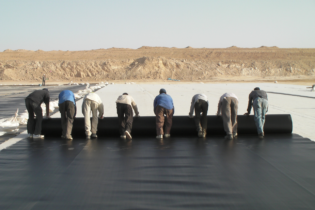A petrochemicals group involved in affordable housing made from mining and manufacturing by-products, as well as an Eco Industrial Park in the hub of the Free State? Could the world’s largest maker of motor fuels from coal and one of South Africa’s largest polluters be on the right path toward sustainability?
According to the country’s 2009 Carbon Disclosure Project (CDP) report, petrochemicals group Sasol topped the list of South Africa’s largest polluters (along with Eskom). The group is the world’s largest maker of motor fuels from coal, and spewed some 70.4 million tonnes of CO₂ into the South African atmosphere alone in 2010. Energy and material sectors remain SA’s largest emitting industries, collectively contributing more than 90% of the country’s emissions, particularly hit by our heavy reliance on coal-fired power plants. Moves to diversify the country’s energy mix away from coal have been slow, especially as Eskom struggles to meet fast rising demand in Africa’s biggest economy, but that is a topic all on its own. Launched in 2000, the Carbon Disclosure Project has, on behalf of institutional investors, challenged the world’s largest companies to measure and report their carbon emissions. The green issue is at the forefront of both the corporate and public mind with big business having recognised the importance and commercial expediency of sustainable business practices. But sustainability means more than corporate responsibility – it is now a bottom line issue that big business needs to integrate into its strategy. Media statements issued in mid 2011, stated that Sasol is to build SA’s largest gas power plant in Sasolburg in the Free State. It is reported that the R1.8 billion facility, which will produce electricity from natural gas, will have a capacity of 140MW and will supply energy to Sasol’s operations. One of the main reasons that Sasol currently holds the title of one of the country’s largest emitters is its dependence on power derived from the burning of coal and, according to the group, electricity produced from natural gas rather than coal will result in fewer emissions. In an article on mediaclubsouthafrica.com, Henri Loubser, MD of Sasol’s New Energy department was quoted as saying: “This project will produce 50% less greenhouse gases compared to a conventional coal-fired power station of equivalent capacity.” He says that the Gas Engine Power Plant project is predicted to enable the reduction of close to one million tonnes per annum of CO₂, once the complete project is rolled out; and the project falls in line with Sasol’s aim to increase the energy efficiency of its South African utilities by 15% per unit of production by 2015. Construction of the plant was due to start in July 2011 and it is expected to start producing electricity by the end of 2012. Whether or not the gas power plant can deliver on its promise to drastically cut the group’s CO₂ emissions remains to be calculated. Green housesAnd it seems that the petrochemicals group is not just investing all its profits into the new gas plant, with other smaller sustainable projects also on the cards. For instance, First National Bank and Sasol have joined forces to develop new affordable houses made from mining and manufacturing by-products. Designed and built using technology developed by Tower Technologies, a subsidiary of EnviroServ Waste Management, the walls and roof of an 85m² home takes just five days to assemble, thereby bringing about significant savings in both construction costs and energy use. According to Marius Marais, CEO of FNB Housing Finance, conventional building methods are becoming increasingly expensive, and impact directly on the ability of banks and developers to meet the need for affordable housing. “Because of this and continued increases in labour costs, we have been compelled to consider alternative technologies that will enable us to deliver affordable quality houses to the emerging middle class,” he adds. The first three housing units have been built in Cosmo City, where market acceptance has been very high, and are made with pre-built panels derived from waste streams – fly ash and gypsum. Fly ash is a by-product of Sasol’s power production and gypsum a by-product of industries such as paper making, fertilizer production, desalination of acid mine water and many more. Waste ash is used in a revolutionary process to create a mixture that is foamed and held together by polymeric binder. The entire foamed mixture is encased in a steel frame structure and this comprises a panel that can be used for any fit for purpose building application.
Mike Symons, CEO of Tower Technologies, commented that the Tower Technologies Building System has the look and feel of traditional brick and mortar with many superior attributes in that the walls are guaranteed straight, solid and are incombustible. The panels are factory manufactured to ensure consistent quality and render an 80% weight saving to conventional building methods which makes it logistically efficient. The panels are manufactured from waste streams and therefore ensure a low carbon footprint and have been fully SABS tested and Agrément certified. In addition, this building system ensures a cost saving of between 10% and 30% to conventional building systems, depending on locality, and is in the process of being licensed to prospective manufacturers, countrywide.
Economic and commercial viabilityWhen asked what the actual cost savings are in Rand when comparing the construction of traditional brick and mortar houses to fly-ash and gypsum houses, the answer was very straight-forward: the bondable houses are 10 – 20% cheaper than conventional housing yet still deliver on quality and meet all building accreditation criteria (SABS, Agrément and NHBRC). For detailed costings, this is done according to each interested investor requirements and is dependent on site location for panel factory manufacturing, as well as the application of these panels according to architectural design. Dependent on these known inputs, a panel costing is given. The typical Cosmo saving for the end consumer was a 20% saving but considering that the land at Cosmo was pricey. Similar building technologies have been around for many years in the alternative market but a large number of these are either too expensive or not socially accepted by the South African market. To have success on both these fronts with a national bank providing 100% bonds for an alternative technology is a great achievement for the project. With the development of the green economy and rise in consciousness toward reducing carbon footprints, there is definitely a trend toward alternative (and green) building technologies. Greener businesses
Sasol’s enterprise development vehicle, Sasol ChemCity, together with the executive mayor of the Metsimaholo Municipality and other key role-players, launched Phase I of their Eco Industrial Park in Sasolburg in October 2011. Situated in the industrial hub of the Free State, the site will provide a reliable supply of utilities, support services and infrastructure, to ensure an environment that is conducive to successful production, logistics and marketing. One of the primary attributes is the park’s ability to minimise its carbon footprint with a long-term strategy to implement carbon reduction projects. Mechanisms are in place for entrepreneurs to utilise alternate building technologies, solar geysers, solar panels and other eco-friendly tools. By bringing revolutionary thinking to the conventional buzz around industrial parks, the project hopes to promote a green building philosophy in other regions in time to come. Even with these and other green projects underway, South Africa’s Carbon Chasm report, compiled by KPMG, illustrates that there is a gap between business as usual carbon emissions and SA’s commitment of 34% below the business as usual scenario by 2020. However, many companies in the South African market have stepped up to the challenge of voluntarily reducing greenhouse gas emissions by putting forward substantive commitments that contribute to meeting the country’s overall commitment. Although it is encouraging to see the articulated voluntary GHG reduction emissions targets in the private sector, it is only through a collective effort that climate change can be seriously addressed. The 2010 CDP report bluntly stated that emissions need to decrease by an estimated 0.2% per year to achieve SA’s 2020 commitment of 34% below business as usual. The projected annual increase in emissions from electricity generation is the primary driver in the country’s annual total emissions growth up to 2020. Bearing this in mind, top carbon emitters such as Sasol, need to ensure that sustainability projects remain at the forefront of their business decisions.








